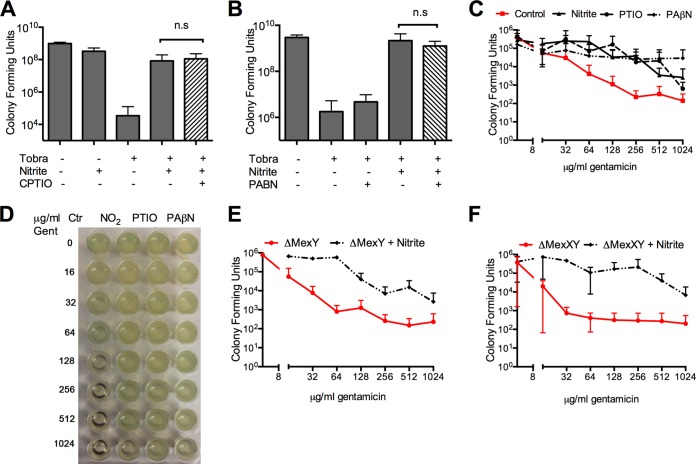FIG 3.
(A) In liquid culture, induction of resistance to tobramycin is not blocked by addition of the nitric oxide scavenger CPTIO. (B) Induction of resistance to tobramycin by nitrite is not blocked by the addition of the efflux pump inhibitor PAβN to a log-phase aerobic culture. Concentrations used were as follows: tobramycin, 2.5 μg/ml; nitrite, 15 mM; CPTIO, 1.5 mM; and PAβN, 20 μg/ml. Brackets indicate differences that are not significant (n.s) by one-way ANOVA (n = 6 for panel A and 3 for panel B). The addition of the nitric oxide scavenger PTIO or the efflux pump inhibitor PAβN did not block the induction of resistance in abiotic PAO1 biofilms grown on microtiter dishes. (C) CFU counts from 24-h biofilms treated for 2 h and then incubated with 1% Triton to recover attached bacteria (n = 4). Differences were analyzed by two-way ANOVA followed by multiple-comparison testing (P < 0.05 for differences between the control and other conditions; differences were nonsignificant for comparisons between nitrite and PTIO or PaβN). Similar results were obtained using 48-h-old biofilms in an MBC-biofilm assay. (D) Representative MBC-biofilm plate with control growth inhibited at 256 μg/ml, while the MBC-biofilm for the other conditions was >1,024 μg/ml (n = 3; a representative image is shown). To confirm that efflux pump upregulation is not required for nitrite-induced gentamicin resistance, ΔMexY (E) and ΔMexXY (F) strains were grown as biofilms on microtiter dishes for 24 h before being treated with gentamicin and 75 mM nitrite for 2 h. Attached bacteria were recovered in 1% Triton and counted. P values were <0.05 by two-way ANOVA for differences between control and nitrite treatments.

